Zotac ZBOX MAGNUS EN970 Review - A Gaming mini-PC Done Right
by Ganesh T S on September 28, 2015 8:00 AM ESTHTPC Credentials
Despite being actively cooled, I was pleasantly surprised by the noise profile of the system. The fans have variable rotational speeds, and in general, for most media related activities, the fan noise is minimal. I would go as far to say that the noise is probably the lowest amongst all the gaming mini-PCs that we have evaluated.
Refresh Rate Accurancy
Starting with Haswell, Intel, AMD and NVIDIA have been on par with respect to display refresh rate accuracy. The most important refresh rate for videophiles is obviously 23.976 Hz (the 23 Hz setting). The Zotac ZBOX MAGNUS EN970 does not have the same out-of-the-box accuracy possessed by Intel and AMD. However, NVIDIA also allows for setting custom resolutions and refresh rates.
The gallery below presents some of the other refresh rates that we tested out. The first statistic in madVR's OSD indicates the display refresh rate.
Network Streaming Efficiency
Evaluation of OTT playback efficiency was done by playing back our standard YouTube test stream and five minutes from our standard Netflix test title. Using HTML5, the YouTube stream plays back a 720p encoding. Since YouTube now defaults to HTML5 for video playback, we have stopped evaluating Adobe Flash acceleration. Note that only NVIDIA exposes GPU and VPU loads separately. Both Intel and AMD bundle the decoder load along with the GPU load. The following two graphs show the power consumption at the wall for playback of the HTML5 stream in Mozilla Firefox (v 41.0).
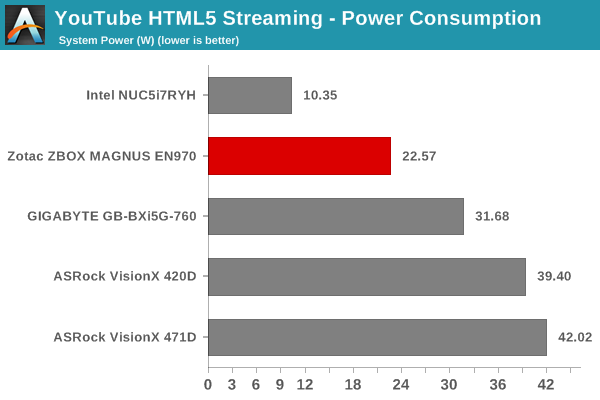
GPU load and VPU load were around 16.01% and 21.42% for the YouTube HTML5 stream.GPU load in the steady state for the Netflix streaming case was 5.88% and the VPU load was 4.36%.
Netflix streaming evaluation was done using the Windows 8.1 Netflix app. Manual stream selection is available (Ctrl-Alt-Shift-S) and debug information / statistics can also be viewed (Ctrl-Alt-Shift-D). Statistics collected for the YouTube streaming experiment were also collected here.

Decoding and Rendering Benchmarks
In order to evaluate local file playback, we concentrate on EVR-CP and madVR. We already know that EVR works quite well even with the Intel IGP for our test streams.
In our earlier reviews, we focused on presenting the GPU loading and power consumption at the wall in a table (with problematic streams in bold). Starting with the Broadwell NUC review, we decided to represent the GPU load and power consumption in a graph with dual Y-axes. Nine different test streams of 90 seconds each were played back with a gap of 30 seconds between each of them. The characteristics of each stream are annotated at the bottom of the graph. Note that the GPU usage is graphed in red and needs to be considered against the left axis, while the at-wall power consumption is graphed in green and needs to be considered against the right axis.
Frame drops are evident whenever the GPU load consistently stays above the 85 - 90% mark. An important aspect to note here for NVIDIA GPUs is that the load reported doesn't take into account the GPU clock. For example, the 4Kp30 clip in the EVR-CP mode: Initially, the GPU and VPU operate at higher clocks, resulting in the reported load being 7 - 8% and the power consumption being around 34W. However, later on towards the end of the stream, the load jumps up to around 12%, but the power consumption is now only around 25 W. Essentially, the power consumption at the wall is the real metric of efficiency for decode and playback. As long as the GPU load stays below the 85 - 90% mark, frame drops don't occur.
EVR-CP and madVR Defaults don't present any challenges to the GTX 960
Since the GTX 960 is a powerful GPU, we evaluated madVR with both default and stress settings. The 'madVR stress settings' was configured with the upscaling algorithms set to Jinc 3-tap with anti-ringing activated and the downscaling algorithm set to Lanczos 3-tap, again with anti-ringing activated.
The ZBOX MAGNUS EN970 was able to handle the madVR stress configuration without any issues.
Moving on to codec support, the GTX 970M / GM204 is a known quantity with regards to the scope of supported hardware accelerated codecs.
There is no HEVC_VLD_Main10 support. This is a bit disappointing since the real desktop GTX 960 supports Main10 decoding in hardware. Other than that aspect, the ZBOX MAGNUS EN970 actually makes for a reasonably power-efficient madVR-capable HTPC.


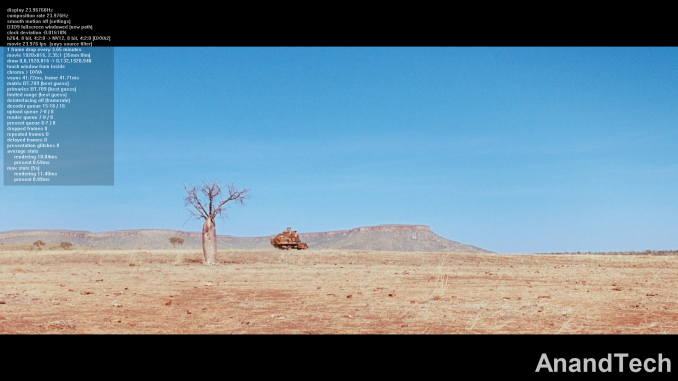



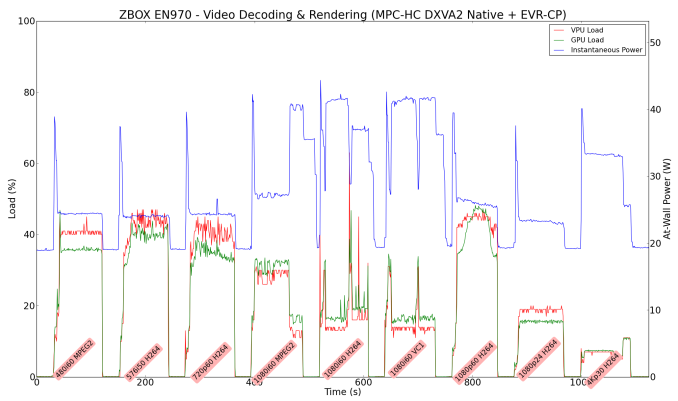
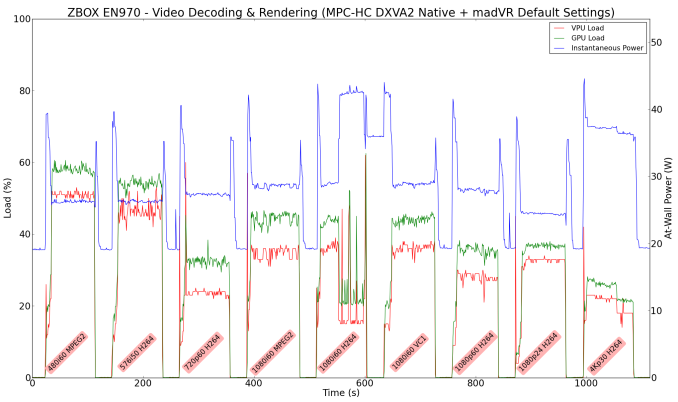
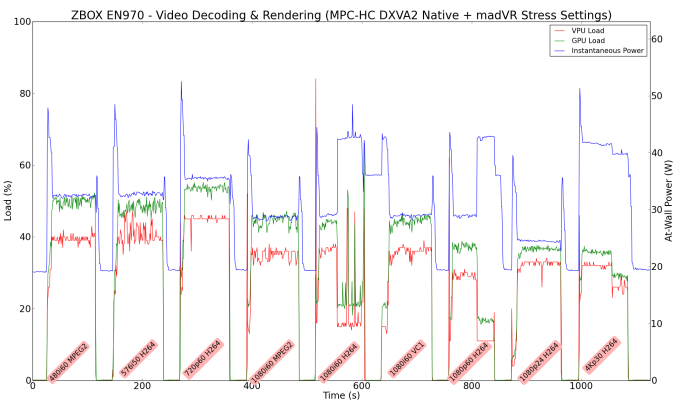
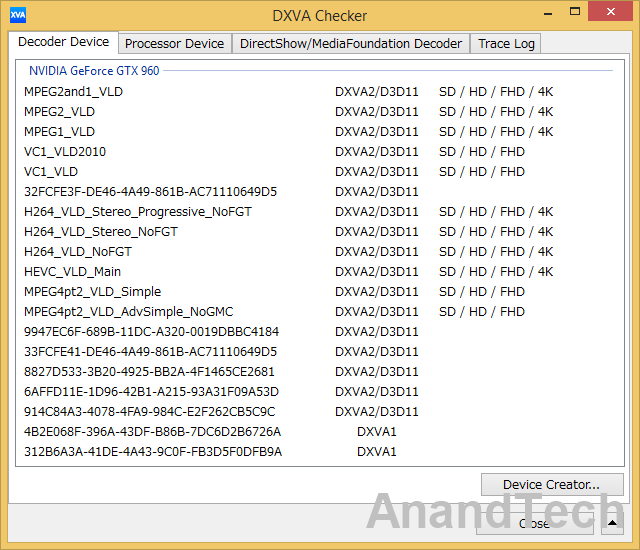








88 Comments
View All Comments
watzupken - Monday, September 28, 2015 - link
I am not sure if it makes sense to pair a decent graphic solution with a Ultra low power CPU to begin with. I believe the constraint is with the cooling solution, but I think I can live with a slightly bigger chassis.firewall597 - Monday, September 28, 2015 - link
I dunno, it seems like a compelling 1080p solution to me. I'm sure they put plenty of thought into their choice, between the pairing of CPU+GPU in such a small package, while also trying to reach a certain price point.Owning a SP3 with a pretty comparable 4300u, it's pretty impressive what it can do all things considered. Being paired with a 970m and put into a tiny $800 package is actually pretty enticing as an HTPC/Steam box solution for the living room.
barleyguy - Monday, September 28, 2015 - link
Agreed. Most living room displays (TV/Projector) are 1080p, and this box performs very well at 1080p. It's small enough to put next to a TV, and should be very quiet as far as fan noise as well.I have an EN760 in my living room. It's an older version of this same box. It works great.
My only complaint is that they raised the price from $500 to $800 (for the barebones) compared to previous generations. $500 was a more compelling price; $800 gets too close to laptop territory.
jameskatt - Thursday, October 1, 2015 - link
Cheapness is why the PC market is dying.SBD-3 - Saturday, October 17, 2015 - link
Portability is why PC's are dying. People want it all in the palm of their hands.LoganPowell - Friday, November 27, 2015 - link
This is one expensive gaming desktop and its not even on the top rank (see http://www.consumerrunner.com/top-10-best-desktops... for example...). Not my first choice as there are better with lesser price on the market.liebezeit - Monday, September 28, 2015 - link
HTPC for $800? My repurposed Asus Chromebox I bought used for $75 works great for me...SirKnobsworth - Monday, September 28, 2015 - link
You wouldn't try any serious gaming on a Chromebox. Similarly, you wouldn't buy this if you just wanted to watch Netflix.firewall597 - Tuesday, September 29, 2015 - link
BUT CAN IT PLAY CRYSIS?This can.
QinX - Monday, September 28, 2015 - link
Any reason as to why you didn't show the heatsink setup/MXM module?I'd be curious to see if you could squeeze in the new GTX980 MXM module in here, yes I know the 5200U is anemic for a GTX980.